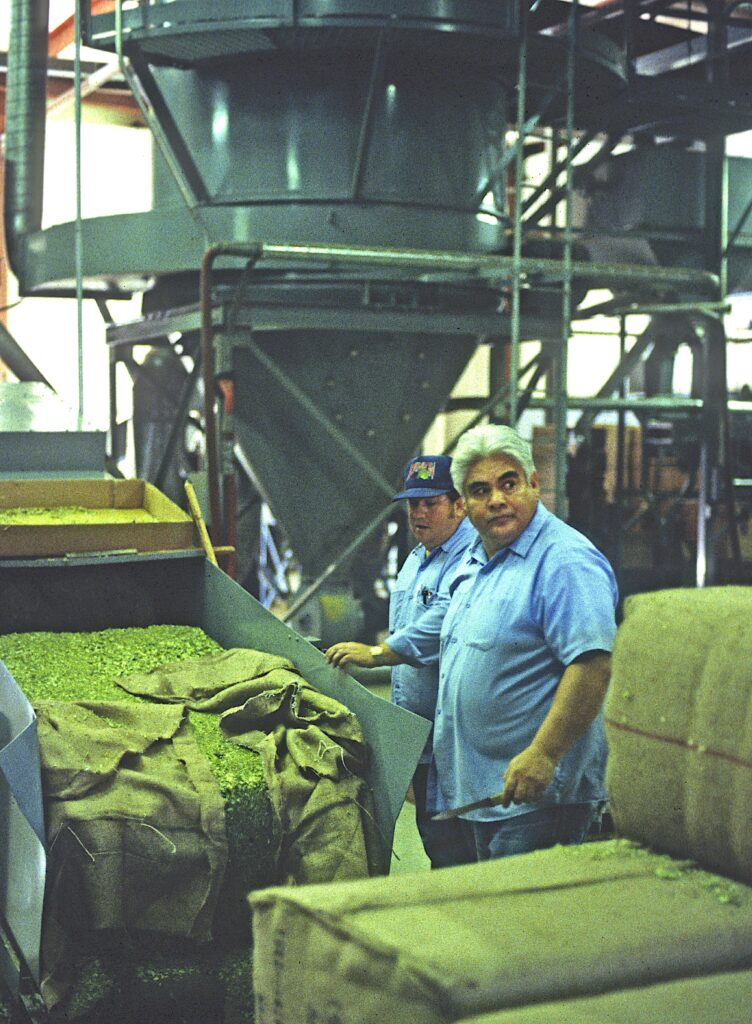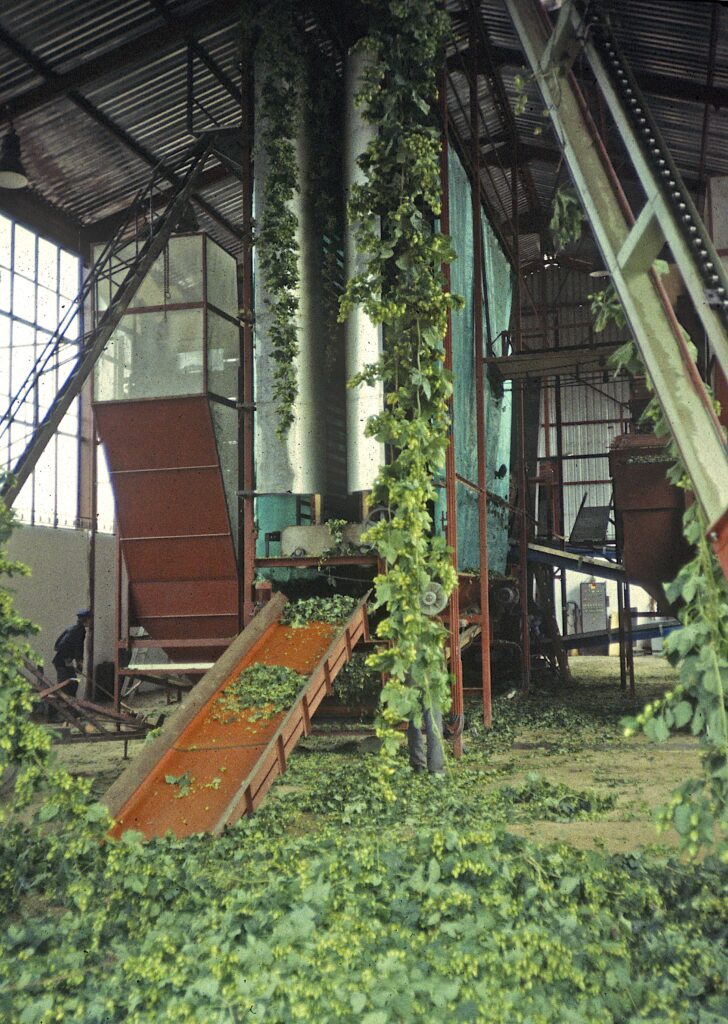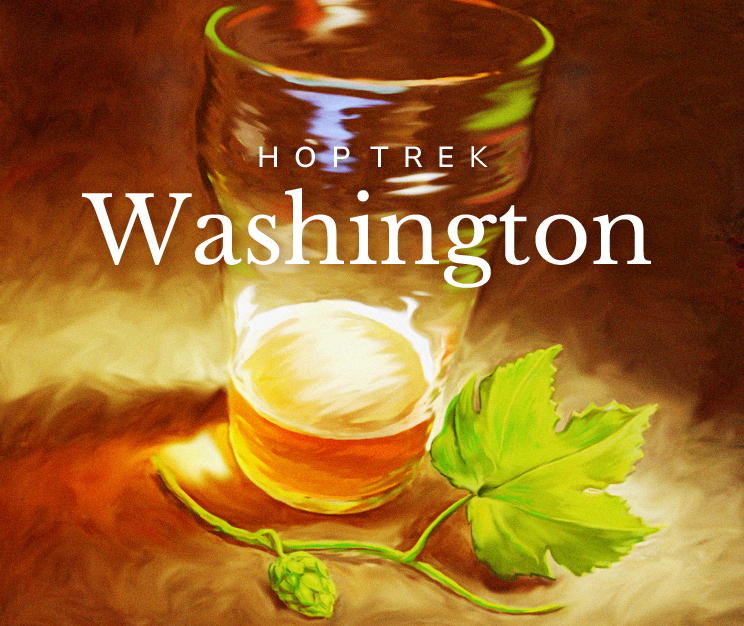© 1996, Randy Mosher / All About Beer Magazine
In early 1995 I was approached by the legendary Ralph Olson of HopUnion with a proposal: If they financed and arranged a trip to cover the hop harvest, would I be willing to make the journey and write a feature for All About Beer magazine, who had agreed to run it? I jumped at the chance, as I couldn’t pass up this opportunity to visit four important hop regions at harvest time and talk to the people who were making it happen. It turned out to be a fun article.
I was gratified the next year when it won the North American Guild of Beer Writers award for best feature article. It was illuminating for me, and I hope you’ll feel a bit of the spirit of being there.
My everlasting gratitude to Ralph Olson and the small-brewery specialist, HopUnion, now merged into Yakima Chief Hops. The article is serialized here on four pages, by region.
To lovers of great beer, hops are a magical ingredient. Capable of taming the sweet excesses of the most toothsome malts, and of adding an ethereal aroma to lagers as well as ales, hops are beer’s perfect herb. For those of us who cherish the hop, the attachment only grows stronger with time.
For the people who live with the hop, and lovingly coax it out of the ground, the bond is even stronger. Steeped in tradition, hops have long intertwined themselves with the lives of their caretakers. A petulant crop, hops can be at once infuriating, intoxicating, and incredibly rewarding. Growers everywhere imbue the hop with a powerful personality—sometimes sadistic, sometimes beatific, always captivating.
YAKIMA – WASHINGTON, USA
I am standing on the base of an upturned tree, on a ridge overlooking the jagged tips of the Cascade Range of northern Washington. It is dark, save for the blue illumination of a new moon. Around me, the ancient sun-baked roots of a toppled spruce tree fan out mechanically in all directions forming a throne Ralph calls the “Starship Enterprise.” For HopUnion’s gregarious leader Ralph Olson, this is a retreat from the high-pressure world of hops down in Yakima, just an hour to the east. The fact that he has bestowed this imaginative fantasy on a dead tree speaks worlds about those who spend time in the hop trade.
Hops are an extraordinary crop. They have a certain power, a personality that commands devotion. The plant is its own metaphor, clinging tendrils clinging to whatever they touch, including human minds. Once you’ve been touched by hops, the Germans say, they will never let you go.
I had, at that moment, been touched by hops for just 48 hours, roaring around the Yakima valley, soaking up the tales and temperament of the American hop-ranching experience. And I would soon be off to do the same in the famous hop fields of Saaz, Hallertau, and Kent. These remarkably different regions and people are connected with a strong common thread, the twisting, encircling bine of the hop plant, Humulus lupulus.
The warehouse in Yakima is starting to fill with part of the 10,000 bales of fresh Tettnangs it will soon hold. The lavender-tinged scent is heady. Things are moving at a brisk, controlled pace: weighing, sampling, stacking. It’s all very low-tech—a few ancient-looking sampling tools, stencils, scales and a forklift or two. The low-tech look belies the electronic veil that connects the world of hop growers, dealers and brewers.
John Farver, a local homebrewer, escorts me to the fields. The Yakima valley is a broad, smooth valley, ringed with deeply-tanned hills, a mantle of deep green irrigated fields draped seductively low on bare earthen shoulders. Far to the west, huge, perfectly-shaped volcanic cones loom, torn directly from the backdrops in Lost Planet.
Hops are not king in Yakima. Apples are by far the dominant crop, with juice grapes, peaches, and herbs like mint competing as well. But the hop yards stand proud, an odd, tall crop, bushy vines supported on complex trelliswork about twenty feet high, dripping with delicate green cones. The highways are strewn with chunks of hop plants fallen from harvesting trailers. “Roadkill,” John says. Local homebrewers make beer from such scraps. Experts can recognize hop varieties on sight, but he thinks the fun of Roadkill Ale is being surprised when you drink it. “Sometimes it’s real bitter.”
On the Sunny Hops Ranch, the crop looks good, the vines bulging with cones. A machete wielded by a man high in a tractor-mounted crow’s nest makes a sound like a Star Wars laser sword as he hacks the vines free from the steel wires at the top of the trellis. Unseen, a woman walks ahead of the truck, crouching as she cuts the vines at their bases allowing them to fall into the open trailer.
The hop-laden trucks pull into a bay at one end of the large picker building. Workers clip the root ends of the vines onto a little hop monorail, which looks like a Wild Mouse roller coaster designed for the torture of hops. The plants dangle vertically, jerking up and around into a space between two diabolical walls of spring-loaded wire fingers which flick and tear at the plant, popping the cones off the vines, along with a considerable quantity of leaves and other green stuff. A good part of the picker is dedicated to separating the cones from this waste material by shaking, rolling, and/or blowing in various inventive ways. The cleaned hops are given a visual inspection and are sent by conveyor to the kiln. Sweet-smelling hop dust falls like a gentle snow. On the conveyor, hashish-like chunks of pure hop resin accumulate and flop to the floor.
The drying kilns are thirty feet across, a hundred feet or more in length, divided into squarish bays, filled three feet deep with hops. They are fired by giant burners—locomotives turned into jet engines as near as I could tell—sending warm air up through the bed of hops. Drying continues for six to eight hours, reducing the moisture level from eighty percent down to about ten.
Nearby in the pellet plant, a machine the size of a house is squeezing fluffy cones into tight little pellets of hops, reducing them to a fraction of their original volume. Next to a chute, a box holds this week’s haul of metallic jetsam: springs, rollers, nuts and bolts. Incongruous items pop up occasionally: a pair of pants, an anatomically correct cigarette lighter, a Timex watch. “It wasn’t ticking,” says my guide.
On the farm, Darryl Dessereault, a semi-retired grower working as a consultant to SunnyHop Ranches, offers his perspective. Until the early 70’s, it was nothing but the traditional American hop, Cluster as far as the eye could see. Then came Bullion and Brewer’s Gold, and later Cascade, a variety much beloved of craft brewers but originally developed for Coors as a replacement for expensive European aroma varieties.
He now enthusiastically seeks out brewpubs and micros wherever he goes. “Boy, it’s funny how a person’s taste can change.” He admits to the pull of beer advertising: “They show all this snow, with these big-busted women. I’d like to go sliding down the snow with someone like that! Sometimes I wonder if I’m drinking the right beer.”
Hops are a difficult crop, he says, but problems are caused more by human nature than mother nature. In fact, the worst years for a grower are those when growing conditions are perfect and the supply exceeds demand.
For centuries, hop markets have been subject to regular booms and busts. When the supply is tight, high prices inevitably attract new acreage. After a three-to-four year time lag it takes until full production is reached, the market chokes on the oversupply. Prices plunge, which in turn creates instability, causing some ranches to fold or be sold. The depressed prices continue, as growers who have invested heavily in new fields are reluctant to tear them out, and everyone would like to see the other guy tear out his hop fields. Eventually the supply contracts, sometimes dramatically and prices shoot way up.
In the US, hop process have sometimes been stabilized by a government price control mechanism known as a Marketing Order. Over the last hundred years, Marketing Orders have been in effect on and off on a pretty regular basis, although the industry is on its own at the moment.
The potential profitability of hop ranching in Yakima has always attracted speculators and gamblers. The chatter during the harvest sounds like a commodities exchange. Hops are mainly bought “on contract” 1-4 years ahead, and there are plenty of games to be played. Conservative growers tend to accept lower prices on longer-term contracts, while more aggressive growers may hold a larger share back to sell on the spot market, a risky, but potentially lucrative strategy. The weather seems to be rather low on the list of concerns.
In the old days, this gambling spirit was carried into late-night poker games, each man accompanied by his own quart of whiskey, the same liquid that once lubricated the contracts between growers and merchants. “One guy had two stomachs, he claimed,” said one grower who recalled those colorful times.
Next stop, Toppenish, self-proclaimed “City of Murals.” There we find the American Hop Museum, located in a thoroughly mural-slathered building that once housed a hop growers supply store. Nick Hughes, nephew of Lloyd Hughes—one of the area’s more colorful characters—presides over this historical collection, and gives us a quick history lesson.
In this area, hop farming began in the Ahtanum Valley, just west of present day Yakima. A mission was established there in 1850, and the Indian treaty was signed in 1855, at which time white settlement increased greatly. The first hop farms were established about 1868-70. It is a beautiful valley with a creek winding through it, lending itself perfectly to simple irrigation projects.
Small farms were the norm in those days, and hops were a very lucrative crop. A big family was helpful, but other than that, not a lot was required: some poles, and some plants, and plenty of effort. The rewards could be great. Prestigious Buicks, Hudsons, and Studebakers were common cars in the valley in the 1930s. Even today, everybody’s got a nice “rig.” Shiny new 3/4 ton extended cab pickups dominate the highways in the valley.
Hop picking was done entirely by hand until after WWII. Vast numbers of temporary workers were called into service during the training season in the spring, and at harvest time. Usually it was the poorer class of city folks, lured out for a working “vacation,” as Hughes says, “…the whole Woodie Guthrie trip.” in 1939, as the country mobilized for war, pickers became scarce, and Indian tribes from as far away as Montana were called into service.
A war of sorts existed between pickers and growers. Since hop pickers were paid by the pound, various tricks were played to tip the weight advantage to one side or the other. An older woman who picked hops before the war was telling her stories to an NPR reporter covering the museum. She described how she and her friends used to drop watermelon rinds, water, dirt and rocks into the sacks to get the weight up; growers would typically kick the bottom of the sacks to detect such fraud. A voice boomed from across the room: “I sure almost broke my toe a couple of times, too.”
At every level, there is a constant jostling for advantage. All players are trying to get the upper hand in a complicated situation that depends on water, brewers, supply, tariffs, public taste, pesticides, and dozens of other uncontrollable factors. “You’re playing that 3-D chess game they play on Star Trek,” said Hughes, whose uncle Lloyd lost the Yakima Chief Ranch trying to corner the spot market in the late 1940s. Sometimes the stakes are even higher. “In 1980 we had $100 million worth of hops sitting on the dock when the US imposed an embargo on exports to The Soviet Union. We had to beg Jimmy Carter to declare hops a ‘non-strategic’ product. It’s real cloak and dagger stuff sometimes. Fabulous business. Kick in the pants!”
It is the next day and I am sitting in the shiniest Jeep I have ever seen, heading out for the Moxee Valley, east of Yakima. This early hop growing part of the area remains a stronghold for Catholic families of French Canadian descent. Steve Desmarais, who has now handed off the family farm to the next generation, reminisces: “It was hard in the old days. My grandfather would work in the fields all day, then go out and clear sagebrush in the moonlight.”
Chinese workers, recruited to dig canals, served as hop pickers, too. “I remember they’d go out in the evening with their long beards and robes, line up side by side, and pass a glass pipe from man to man. ‘That’s their medicine, my dad would say.” Later, when Indians were used as pickers, the farms used to put them on trucks and bring them all to one farm or another, “There were always big stick-games (gambling) that went on all night.”
The younger generation has seen a lot of change, too. Bob Charon, Desmarais’ nephew, says: “When I was growing up, the Moxee valley was nothing but hops. It used to be a strong Catholic community. We were all altar boys.” But other crops have moved in and “The quiet country life is gone,” says his sister, Cindy Charon, still involved in their family’s large farm. Bob adds: “It worries me now that the older folks are gone and we don’t do the things they used to do.”
On the way back to Yakima, we pass a semi-trailer that has spilled several bales of hops, producing yellow-green tire tracks all over the highway. For sure the nicest-smelling truck wreck I have ever encountered.
Below left: Bales of hops are loaded into the pelletizer, which compresses them into small pellets that look like rabbit food.
Below right: For harvesting, hops are cut from their roots and brought to a stationary picker, where little metal fingers remove the cones from the vines.



